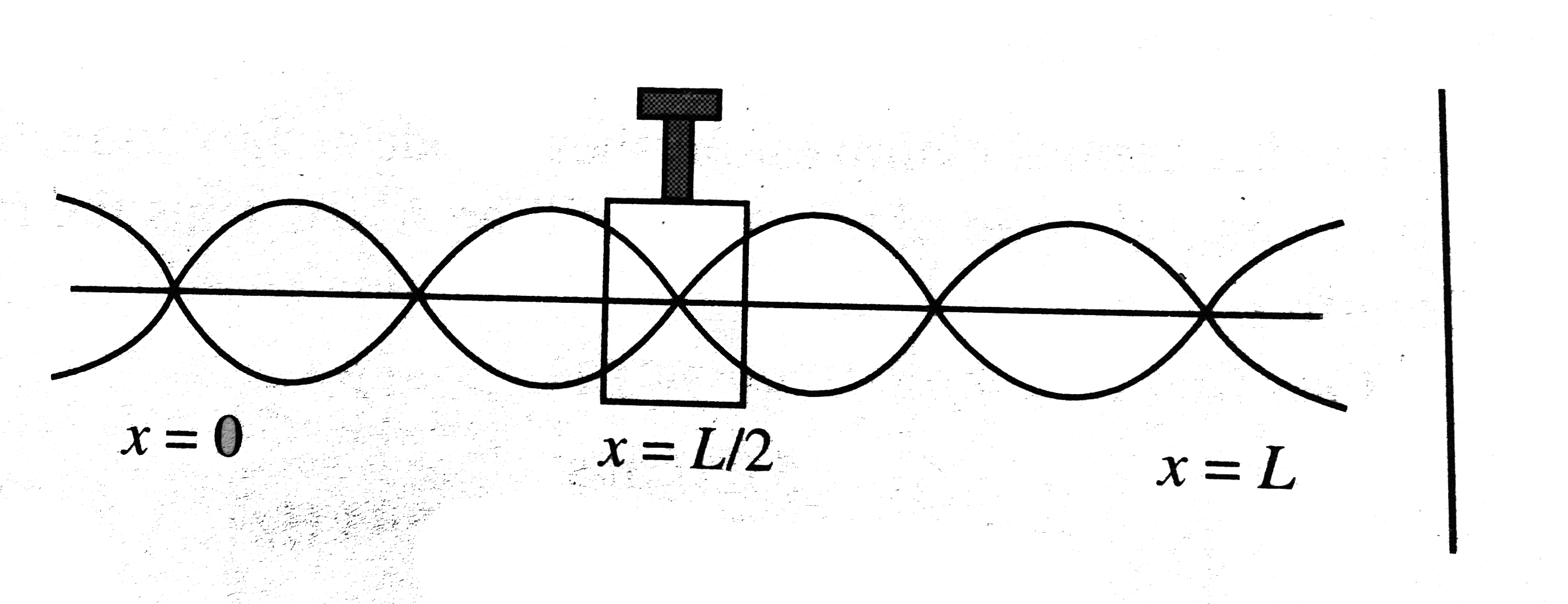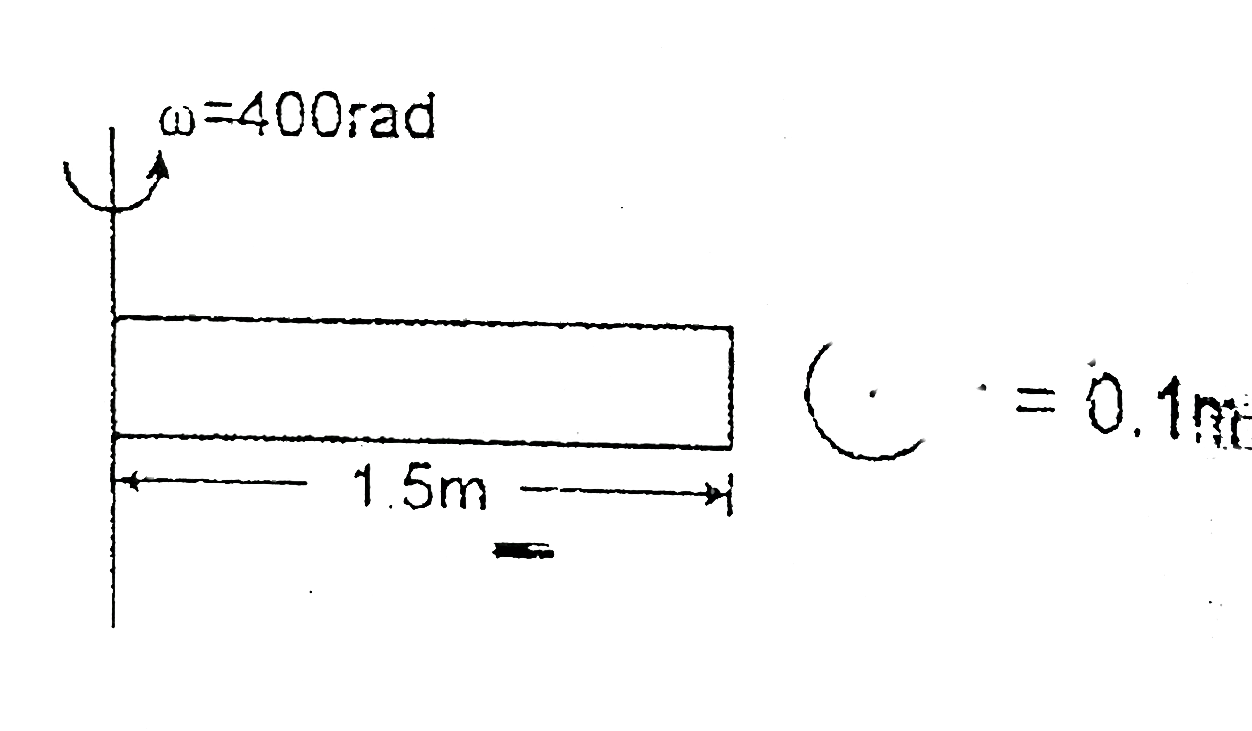A metallic rod of length 1m is rigidly clamped at its midpoint. Longitudinal stationary waves are set up in the rod in such a way that there are two nodes on either side of the mid - point and those of constituent waves in the rod . (Y=2×1011N/m2andρ=8×103kg/m3)
As found in case of strings , in case of rods also the clamped point behaves as a node while the free end antinode . The situation is shown in Fig . 7.63.
Because the distance between two consecutives nodes is (λ/2) while between a node and antinide is λ/4 , hence
4×[λ2]+2[λ4]=Lorλ=2×15=0.4m
Further , it is given that
Y=√Yρ=√2×10118×103=5000m/s
Hence , from v=nλ,
n=vλ=50000.4=12500Hz
Now if incident and reflected waves along the rod are
y1=Asin(ωt−kx)andy2=Asin(ωt+kx+ϕ)
Hence , from v=nλ ,
n=vλ=50000.4=12500Hz
Now if incident and reflected waves along the rod are
y1=Asin(ωt−kx)andy2=Asin(ωt+kx+ϕ)
The resultant wave will be
y=y1+y2A[sin(ωt−kx)+sin(ωt+kx+ϕ)]
=2Acos(kx+ϕ2)sin(ωt+ϕ2)
Because there is an antinode at the free end of the rod , hence amplitude is maximum at x=0 . So
Cos(k×0+ϕ2)=Maximum=1i.e.,ϕ=0
And
Amax=2A=2×10−6m (given)
y=2×10−6coskxsinωt
y=2×10−6cos[2πxλ]sin(2πnt)
Putting values of λandn , we get
y=2×10−6cos5πxsin25000πt
Now , because for a point 2cm from the midpoint x=(0.50±0.02), hence
y=2×10−6cos5π(0.5±0.02)sin25000πt

Similar Questions
A metallic rod of length 1m is rigidly clamped at its mid point. Longirudinal stationary wave are setup in the rod in such a way that there are two nodes on either side of the midpoint. The amplitude of an antinode is 2×10−6m. Write the equation of motion of a point 2 cm from the midpoint and those of the constituent waves in the rod, (Young,s modulus of the material of the rod =2×1011Nm−2 , density =8000kg−m−3). Both ends are free.
View SolutionA metallic rod of length 1m is rigidly clamped at its mid point. Longirudinal stationary wave are setup in the rod in such a way that there are two nodes on either side of the midpoint. The amplitude of an antinode is 2×10−6m. Write the equation of motion of a point 2 cm from the midpoint and those of the constituent waves in the rod, (Young,s modulus of the material of the rod =2×1011Nm−2 , density =8000kg−m−3). Both ends are free.
View Solution
Knowledge Check
A metallic rod of length 1m has one end free and other end rigidly clamped. Longitudinal stationary waves are set up in the rod in such a way that there are total six antinodes present along the rod. The amplitude of an antinode is 4×10−6m. young's modulus and density of the rod are 6.4×1010N/m2 and 4×103Kg/m3 respectively. Consider the free end to be at origin and at t=0 particles at free end are at positive extreme.
The magnitude of strain at midpoint of the rod at t=1sec isA11√3π×10−6B11√2π×10−6C10√3π×10−6D10√2π×10−6A metallic rod of length 1m has one end free and other end rigidly clamped. Longitudinal stationary waves are set up in the rod in such a way that there are total six antinodes present along the rod. The amplitude of an antinode is 4×10−6m. young's modulus and density of the rod are 6.4×1010N/m2 and 4×103Kg/m3 respectively. Consider the free end to be at origin and at t=0 particles at free end are at positive extreme.
The equation describing stress developed in the rod isA140.8π×104cos(112πx+π)cos(22π×103t)B140.8π×104sin(112πx+π)cos(22π×103t)C128π×104cos(5πx+π)cos(20π×103t)D128π×104sin(5πx+π)cos(20π×103t)A metallic rod of length 1m has one end free and other end rigidly clamped. Longitudinal stationary waves are set up in the rod in such a way that there are total six antinodes present along the rod. The amplitude of an antinode is 4×10−6m. Young's modulus and density of the rod are 6.4×1010N/m2 and 4×103Kg/m3 respectively. Consider the free end to be at origin and at t=0 particles at free end are at positive extreme.
The equation describing displacements of particles about their mean positions isAs−4×106cos(11π2x)cos(22π×103t)Bs=4×10−6cos(11π2x)sin(22π×103t)Cs=4×10−6cos(5πx)cos(20π×103t)Ds=4×10−6cos(5πx)sin(20π×103t)
A metallic rod of length 1m is rigidly clamped at its end points. Longitudinal stationary waves are setup in the ord in such a way that there six antinodes of displacement wave observed along the rod. The amplitude of the anotinode is 2×10−6m. Write the equations of the stationary wave and the component waves at the point 0.1m from the one end of the rod.
[Young modulus =7.5×1010N/m2, density =2500kg/m3]
View SolutionA metallic rod of length 1m has one end free and other end rigidly clamped. Longitudinal stationary waves are set up in the rod in such a way that there are total six antinodes present along the rod. The amplitude of an antinode is 4×10−6m. young's modulus and density of the rod are 6.4×1010N/m2 and 4×103Kg/m3 respectively. Consider the free end to be at origin and at t=0 particles at free end are at positive extreme.
The magnitude of strain at midpoint of the rod at t=1sec is
View SolutionA metallic rod of length 1m has one end free and other end rigidly clamped. Longitudinal stationary waves are set up in the rod in such a way that there are total six antinodes present along the rod. The amplitude of an antinode is 4×10−6m. young's modulus and density of the rod are 6.4×1010N/m2 and 4×103Kg/m3 respectively. Consider the free end to be at origin and at t=0 particles at free end are at positive extreme.
The equation describing stress developed in the rod is
View SolutionA metallic rod of length 1m has one end free and other end rigidly clamped. Longitudinal stationary waves are set up in the rod in such a way that there are total six antinodes present along the rod. The amplitude of an antinode is 4×10−6m. young's modulus and density of the rod are 6.4×1010N/m2 and 4×103Kg/m3 respectively. Consider the free end to be at origin and at t=0 particles at free end are at positive extreme.
The equation describing displacements of particles about their mean positions is.
View SolutionGiven Y=2×1011N/m2,ρ=104kg/m3
Find out elongation in rod.

View Solution
